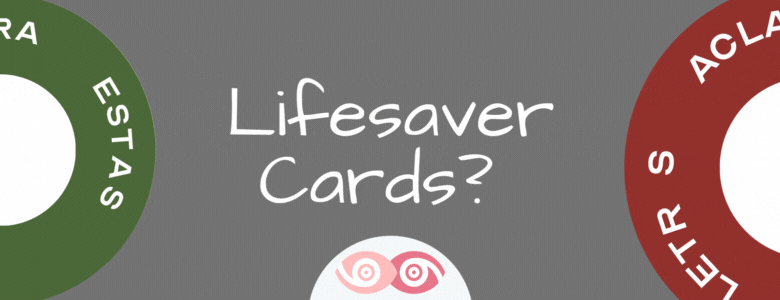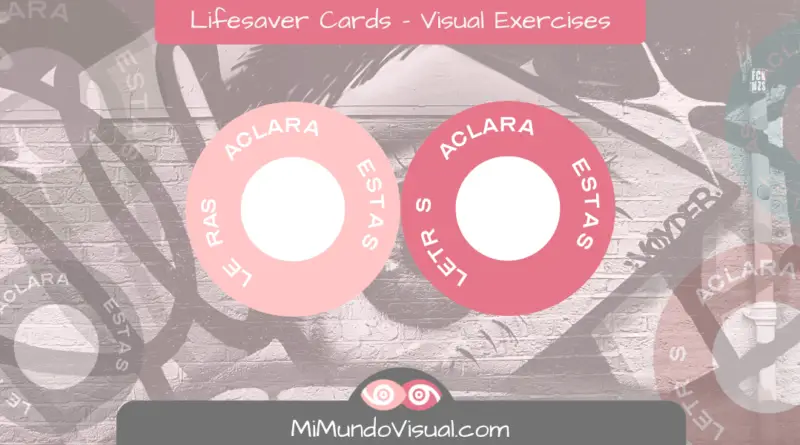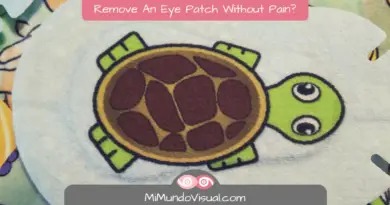Lifesaver Cards For Vision Therapy – Convergence And Divergence
Table Of Contents
Lifesaver Cards are used in vision therapy to work on convergence and divergence in amblyopia.
In the following blog post, we want to learn everything there is to know about Lifesaver Cards.
We will explain why this is a perfect exercise to work on convergence and divergence of your vision and how to work on vergences in vision therapy.
To do this, we will look at the following:
- What are Lifesaver Cards
- What are Lifesaver Cards used for?
- Explain what fusional vergences are. We will discuss both positive fusional vergences and negative fusional vergences.
We will also discuss the following:
- What is a convergence, Lifesaver Card
- What is a divergence Lifesaver Card
- What are convergence and divergence Lifesaver cards
- How to work with each of them,
- What their objectives are,
- How do we use them
- Exercises to work with Lifesaver Cards.
At the end of this article, we will also attach a PDF we created with some FREE Lifesaver Cards for you to practice.
Vision Therapy Exercises
- Eccentric Circles
- Lifesaver Cards For Convergence And Divergence
- Mazes as Vision Therapy Exercises!
- Brock String
- Marsden Ball
- 5 Activities To Do While Wearing An Eye Patch
- Lazy Eye – 5 Games And Activities For Adults
Download Our Lazy Eye Guide!
What are Lifesaver Cards?
The Lifesaver Card, or the Hendrickson Lifesaver Card, is a booklet with 4 pairs of circles.
The distances between the pairs of circles go from smaller to larger as we move through the lifesaver card, from bottom to top, thus increasing the difficulty of the exercise.
The circles on the left side are usually green, while the circles on the right side are red. Although we can also find them the other way around.
We can usually observe the following phrase in each circle: ‘ ACLARE ESTAS LETRAS – CLEAR THESE LETTERS.’
In the lower pair of circles, the phrase appears in its entirety, with all the letters. At the same time, as we move upwards, we see how some of the letters disappear, always different for each pair.

For example, observe the second pair of circles starting from the bottom:
We see how the red circle on the right has the incomplete sentence: ACLARE EST S LETR S.
While in the left circle of green color, the incomplete sentence appears as follows: ACLARE E TAS ETRAS.
By merging both eyes, we will obtain the whole sentence with all its letters. This will serve as an accommodative control.
If you want to know more about accommodation, vergences, and phorias, you can check the article: Convergence and Divergence.
There is another version in which, instead of circles, there are drawings. For example, pictures of animals are distributed in the same way. These are often used to work with children as they are much more appealing to them, and they do not need to know how to read.
We have one at home, where the lower pair is composed of two octopuses, one green and one red, followed by a pair of frogs, a pair of fish, and finally, at the top of the life card, there is a pair of crabs, each of them of one color, one green and one red.
These Life Saver Cards are based on the same principle, only here we are dealing with animals. They do not have a sentence inside the drawing, which has to be completed with the help of the two eyes.
What is the purpose of Livesaver Cards?
The lifesaver cards are used to work on the following:
– Crossed fusion in convergence: by converging the two circles next to each other. When the right eye fixes the left circle, and the left eye fixes the right circle.
– The uncrossed fusion in divergence is achieved by consciously diverging the two circles when the right eye fixes the right circle, and the left eye fixes the left circle.
Lifesaver Card For Convergence
The convergence Lifesaver Card is an opaque plastic card. Its objective is positive fusional vergence by crossing the visual axes in front of the card.
This card aims to improve the ability to converge without significant effort, i.e., sharpness and merging of the two images.
- We fix our gaze on the Lifesaver Card, and with the help of the tip of a pencil or a long stick, we will see 4 circles, two green and two red (this is due to physiological diplopia, i.e., we will see them double).
- Once we are aware of the 4 circles (simultaneous vision), we will try to merge the two central circles, one red and one green, into a single circle.

This will be the merged image, and it will be a brown or maroon circle, neither green nor red, but a mixture of both colors.
We will see this image floating and closer to us than the other circles.
As we go from one pair of circles to another and fuse both, the central fused image will be seen closer and closer and with greater stereopsis.
What are fusional vergences?
What is positive fusional vergence, and what is negative fusional vergence?
When discussing fusional vergence, we refer to binocular movements of the eyes in opposite directions.
This is when the angle of the crossing of the visual axes varies to obtain a fusion of the two monocular images provided by each eye.
As we can see in the following final thesis, there are different ways of classifying vergence, depending on whether we classify it according to the orientation of the eye movement or according to the stimulus necessary to activate the vergence.
According to the orientation of the eye movement, we can differentiate between:
- Horizontal vergences: convergence and divergence.
- Vertical vergence: infravergence and supravergence.
- Cyclovergence: inciclovergence and exciclovergence.
Depending on the stimulus to activate the vergence:
- Tonic vergence
- Proximal vergence
- Accommodative vergence
- Fusional vergence
With positive fusional vergence or convergence, the eyes move inward. With negative fusional vergence or divergence, the eyes move outward.
On this occasion, we will not go into detail to study any other vergence since it goes beyond the topic for today’s article on Lifesaver Cards.
Exercises with the convergence Lifesaver card
Exercise 1: Convergence
- We hold the life card at 40 cm, and with the help of a pointer, we will fix our sight between the last line of circles (lower pair), feeling how our eyes cross, and we perceive the sensation of depth, fusion, and sharpness.
- We bring the life card as close as we can to our nose without ceasing to perceive the fusion, and little by little, we will separate it from our nose until we can fuse with clarity.
Exercise 2: Convergence
- If we can do the first exercise without complications and without the help of the pointer. We can practice ‘jumps’ randomly from one line of pair of circles to another as fast as possible.
- We look away from the life card for a few moments, fix our gaze in the distance, and repeat the exercise.
Lifesaver Card For Divergence
The divergence Life Saver Card is a transparent PVC card. Its objective is negative fusional vergence by crossing the visual axes behind the card.
The procedure for the Divergence Life Saver Card ( translucent divergence card) is similar to the Convergence Life Saver Card.
The card has two series of circles. The ones on the left side are usually green, and the series of circles on the right side are red. Although we can also find versions in which the colors are reversed.
The distance increases between the two pairs of circles as we move up the lines of circles across the card.
The lower pair of circles have a smaller distance between them, and the upper pair has a greater distance between them, making it more difficult to merge.
What are we improving when using a divergence Life Saver Card?
A divergence life card helps to improve the following:
- Simultaneous vision control,
- voluntary fusion in open space,
- visual axis control, a
- accommodation and
- negative fusional vergence.
As with the convergence life Saver Card, we can use a pencil or a long stick to help us fixate the fusion.
But in this case, we will place it behind the card rather than in front, between us and the card.
By placing the tip behind the card, we should be able to see 4 circles (simultaneous vision). Once we have the 4 circles, we must fuse the two central circles, green and red.
Exercises with a divergence Lifesaver card
- We will use a transparent card and place the pointer behind the life card.
- We will change the distance at which we place the card to be able to diverge. If this is too difficult, we can decrease the distance between the card and our eyes while we move the pointer away.
- We will perform the same two exercises as our convergence exercise, with the two differences we have just pointed out.
The objective of the Live Saver Cards
The Life Saver card exercises aim to improve or maintain the brain’s ability to fuse two images (each provided by one eye).

Instructions for using the LifeSaver Card
Instructions for using the LifeSaver Card
- We hold the opaque card about 40 cm from our eyes.
- We take a pencil or a long stick with the tip pointing upwards and place it in front of the Life Saver Card between the two circles at the bottom of the card.
- We fix our gaze on the tip of the pencil or toothpick and keep it fixed on that point.
- As we bring the pencil or toothpick toward our nose, the two lower circles will separate, and we should see 4 circles.
- And later, a third circle between the first two. If we cannot see the central circle, we will bring the pencil or toothpick closer to our nose.
- This third circle that appears to us has a brownish color, a mixture of the two previous colors, and it is neither green nor red and appears to be floating in front of us. If we fail to see it in this color, we will try to blink and move our head slightly.
- The small phrase ‘ACLARE ESTAS LETRAS’ ‘CLEAR THESE LETTERS’ should appear in its entirety with all the letters.
- When moving the head sideways and up and down, the central image should still be present with all the letters.
- When we can keep the central circle with the first two lower circles, we will try to do it with the rest of the upper circles, moving up one line each time.
- When we feel we can do the exercise with ease, we will try to do it without the help of the pointer.
The purpose of this lifesaver card is to work on convergence.
Lifesaver Cards PDF - FREE PDF Download
Free PDF with lifesaver cards designed to work on convergence.
We have developed a series of lifesaver cards, somewhat different and in different colors from the usual ones.
This way, we can have more variety when practicing these visual exercises at home and maintain motivation when doing them.
We hope you enjoy these kid-friendly lifesaver cards and can share them with your family and friends!




